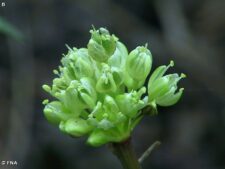
In April this unusual native plant produces flat onion scented leaves up to 12 inches long and 2 inches wide from a perennial bulb (A,D). In June or July, after the leaves have withered or disappeared, a globe-shaped flower head, consisting of many small white or greenish-white flowers appears on a leafless, reddish stalk up to 15 inches long (B). The green fruit clusters appear in July (C).
Grows in moist woodlands, flowering in June and July. The conspicuous leaves are commonly seen along trails, mainly in moister ravines and hollows and along Rock Creek at Neale Woods in April. Flowering plants, unlike the leaves, are seldom seen. The author has looked for them often, but only seen them once (yes, they’re the ones in the photos)! They may have simply been overlooked, but I suspect many of our plants produce leaves but do not flower. Wild Leek does not occur in Fontenelle Forest.
Wild leek bulbs and leaves were widely used by Native Americans as food or seasoning. The name Chicago originated from a Menomini word for wild leek.
Ramps is another common name for Wild Leek.
The content of NatureSearch is provided by dedicated volunteer Naturalists of Fontenelle Forest who strive to provide the most accurate information available. Contributors of the images retain their copyrights. The point of contact for this page is: Neal Ratzlaff.

 Identification
Identification

